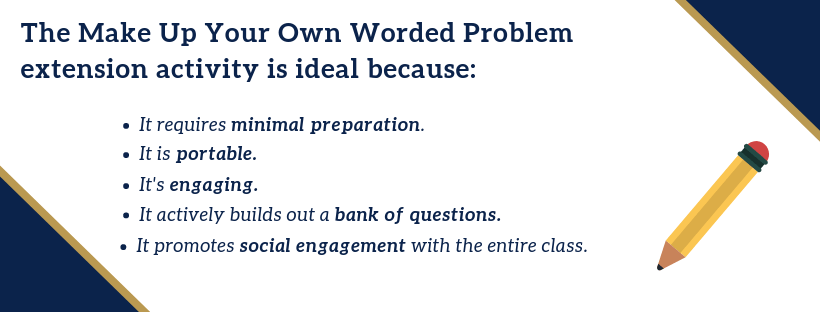The Best-Ever Mathematics Extension Activity Explained.
(Help! Some Students Are About To Finish Two Lessons Early - What Do I Do?)
‘What do I do with the early finishers?’I am often asked this question by the teachers I work with. The question most often arises when teachers implement student-centred units of work, units that tend to invite early finishers.
So - great question - what do we do with the early finishers? We need some early finisher activities! Teacher-centric, procedurally-based teachers may rarely face the situation where a student completes a unit more than a lesson early. They will usually direct the student to challenging textbook questions when they do. This can be OK. However, some students see text-based ‘extension’ work as simply ‘extra work’ and not particularly engaging, perceiving such extension work as an imposition for finishing early. |
Another option is to compile a bank of engaging problem-solving problems that students access when required over the year. This is a great option.
However, the initial effort required to set up such a bank can be considerable. Also, such a system can be challenging for ‘mobile’ teachers - those who do not have one designated classroom.
However, the initial effort required to set up such a bank can be considerable. Also, such a system can be challenging for ‘mobile’ teachers - those who do not have one designated classroom.
The best-ever, you-beaut, wow-ee extension activity!
This extension activity is exceptional for six reasons:
- It is student-centric, creative, open-ended and therefore highly engaging.
- It is easy to differentiate.
- It can be applied to any topic.
- It has the potential to involve all students, even those not directly undertaking the activity.
- It doesn't require a large bank of questions for you to carry around.
- It requires minimal preparation.
Sound interesting?
But first, a warning!
After I announce the name of this ‘best-ever’ extension activity, you will need to keep reading. This is because, at first glance, you’ll likely think, “How can THIS activity be THAT good?”
Drum roll …
“Make up your own worded problem.”
There! I warned you! It doesn’t sound that impressive, does it?
Believe me; the Make Up Your Own worded problem extension activity is brilliant, so please read on …
Believe me; the Make Up Your Own worded problem extension activity is brilliant, so please read on …
Worded Problem?
By ‘worded problem’, I mean a problem or question that requires a few steps, some mathematical thinking and more than a few minutes to answer; a problem that a learned, mathematical procedure cannot answer.
Have you ever made up your own maths worded problem for your students? (If you are a maths teacher, then yes, you have!) And when you are in the middle of making up a good worded problem, have you ever thought (in addition to “Gee I’m brilliant!”) … “Wow, there’s a lot of maths involved in making up these problems!” And “This is a lot of fun!!” Correct? Well, here lies the extension activity - have students make up their maths word problem.
Have you ever made up your own maths worded problem for your students? (If you are a maths teacher, then yes, you have!) And when you are in the middle of making up a good worded problem, have you ever thought (in addition to “Gee I’m brilliant!”) … “Wow, there’s a lot of maths involved in making up these problems!” And “This is a lot of fun!!” Correct? Well, here lies the extension activity - have students make up their maths word problem.
Suggested steps
The success of this extension activity is dependent on the setup. Below are some recommended steps for helping your students create their own math word problem.
One: Guide the student into the type of worded problem to create.
- To maximise student engagement, students need to be able to choose the type of problem they create. However, the activity will fail if students choose to create a question that is too difficult. Therefore:
- Give the student a few choices of problems (show them several text examples) but limit the difficulty to one or two levels below the maximum difficulty to which the student can cope. This is critically important.
Note also that in each case, it is important to explain WHY you are limiting the difficulty of their to-be-created worded problem, so they understand you want them to maximise the amount of mathematical benefit they can receive from the activity.
You can achieve this in two ways:
Ask the student to create a worded problem that most class members will be able to answer. Alternatively, you can point out a specific textbook example and say “Create a problem roughly to this level of difficulty”.
Two: Create a rough copy with a valid solution.
- Creating the worded problem and its valid solution is the main task.
- You will need to check the solution to ensure its validity prior to Step Three.
Three: Create a neat copy of both the problem and solution.
- The student now needs to create a neat copy. This is extremely important and paves the way for the highly engaging and mathematically valid social-engagement aspect!
Four: Photocopy the worded problem and solution and add to your bank of extension questions.
- Once the neat copies have been submitted, photocopy both the problem and the solution.
- You may want to make several copies of the worded problem.
- Add the copies to your worded problem bank.
Five: Have other students answer the problem.
- This is where the activity really takes on a life of its own!
- If you’ve been running this activity in previous years for the same unit, you’ll have a bank of excellent worded problems and solutions from past students.
- These problems can now be incorporated into the unit of work.
- This means that during the final few lessons of the unit, most students will work through problems that have just been created by students - current or past - who have engaged in the extension activity.
- However, to take advantage of student engagement, it is ideal that current students' newly-created problems are prioritised when handed to other students to work through.
Time requirement
|
Note that the activity will require a minimum of a couple of lessons plus homework, assuming you want to reap the benefits of both problem-making and social engagement. However, one lesson plus homework will be sufficient to produce a neat copy of the worded problem and its solution ready for use later.
Alternatively, this extension activity could be used over a three-five lesson time-frame:
|
For a quick explanation, watch this ...
|
In summary
The Make Up Your Own Worded Problem extension activity is ideal because it:
- Requires minimal preparation.
- Is portable.
- Is an engaging activity for students to create worded problems.
- Actively builds out a bank of problems that the class find engaging to work through.
- Creates social engagement with the entire class.
Subscribe to receive free tutorials, information and to stay in touch
Call to Action
What do you think? Is this an extension activity you already use? If not, are you tempted to try it or do you already use an extension activity that is highly engaging, requires minimal prep and is super easy to run? Whatever your situation, we’d love to hear from you.
NOTE: Create a Hyvor account before commenting so you are notified of replies to your comment (if you don't you'll be anonymous) ... OR ... state your name at the start of your comment. Thanks.
NOTE: Create a Hyvor account before commenting so you are notified of replies to your comment (if you don't you'll be anonymous) ... OR ... state your name at the start of your comment. Thanks.
Some Past Comments






